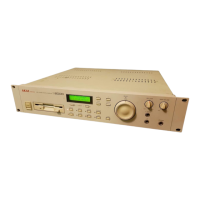PROGRAM EDIT
S2000 Operator’s Manual - Version 1.30 Page 75
MONITORING OTHER PROGRAMS
When in EDIT SINGLE, you will normally only want to listen to the program currently being
edited. There may be occasions, however, when you want to be able to hear other programs at
the same time. For example, in the case where you have two or more programs sharing the
same program number for layering, you may want to hear the other programs in the layer as you
edit the one currently selected. Similarly, when using a multi-timbral setup created using the
‘old Akai’ mode, you may want to hear the other programs in the setup. This is achieved on the
next page down:
Here, you may select between SINGLE and ALL. SINGLE selects that you will only be able to
hear the currently selected program; ALL selects that you can hear all other programs that
share the same program number.
PROGRAM POLYPHONY AND PRIORITY
It is also possible to set the program’s polyphony. This is largely retained for historical purposes
to maintain compatibility with disks made on older Akai samplers:
You may set polyphony to be between 1 and 32 voices. Normally, of course, you will use the
default of 32 but, when loading sound data made on earlier Akai samplers, this may be set
differently. For example, on the S1000, S1100 and early versions of S3000 series samplers,
the way to create drum programs was to create a separate hi-hat program with a polyphony of 1-
voice and layer that on top of the main drums program (i.e. set the drums and hi-hat programs
to the same program number) so that the closed hi-hat would shut off the open hi-hat. In the
S2000, the MUTE GROUP function described later achieves this more elegantly but, in order
to maintain compatibility with programs made on earlier Akai samplers this function is retained
here.
When layering several programs together in SINGLE mode for multi-timbral sequencing (i.e.
using the ‘old’ Akai method), you may wish to set the priority of certain programs. The choices
are:
LOW notes from this program will be stolen first.
HIGH notes from other programs with lower priority will be stolen first before they are
stolen from this program.
NORM this sets standard dynamic voice allocation and note stealing will take place
with no particular priority.
HOLD notes can only be stolen from this program by the same program.
Use F1 and F2 to select the parameters and use the DATA wheel to set the values.
As with the POLYPH function, the PRIORITY parameter is also retained for compatibility with
data created on older Akai samplers. For multi-timbral applications, we recommend the MULTI
mode but, in cases where you have loaded an older multi-timbral set-up, this parameter is
retained.

